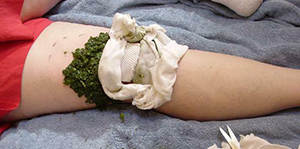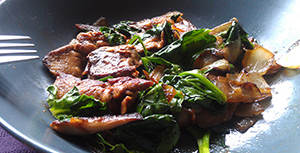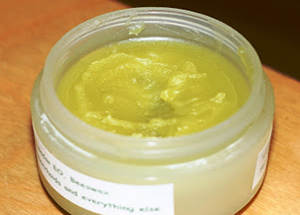Plantain, not to be mistaken with the banana type fruit, also known as Plantain, is a plant that can be found almost anywhere. When you’re not really living in the city, it’s kind of hard not to run into it.
Plantain it’s super nutritious, quick to recognize, has no poisonous lookalikes and it’s used as a medication.
Medicinal Uses:
The leaves contain some interesting bio-active compounds:
Allantoin: This chemical is an anti-inflammatory good for treating wounds and autoimmune diseases. Interestingly enough, allantoin is an ingredient in a few cosmetic creams due to its cell growth stimulating properties and can also be used in nappy rash creams in infants (see recipe section later in this article).
Flavonoids: Studies have reported a number of flavonoid medicinal uses including anti-microbial (including anti-virus, bacteria, and fungus) and anti-diarrheal.
Phenolic compounds: These are another category of chemicals that have antioxidant properties that are beneficial for a wide range of conditions (such as prostatitis).
Plantain compounds make it a highly viable medicinal-purpose plant when there is no modern medicine available.
Dishes and Medical Recipes With Plantain:
A Plantain Poultice
(Source: ‘The Herbal Medicine Makers Handbook: A Home Manual’ by James Green)

This recipe combines the plantain’s anti-inflammatory and anti-microbial activity. This is useful for wounds, sores and bites of insects like that of the brown recluse spider bite.
- Take a couple of Plantain leaves
- Mash the leaves (or better still chew them, our saliva can help release the active ingredient for the poultice – if you do this, don’t ingest the juice as you need it for the poultice).
- Warm up the resulting mash in your hand and put it on the affected area.
- Alternatively, use the leaves from a Plantain tea (see Plantain tea recipe below) and use it as the poultice instead.
Related: 10 Medical Home Emergencies and How to Treat Them
Plantain Tea
Herbal tea is nothing unusual and Plantain can be used to produce an infusion that can be used for a wide variety of digestive disorders including diarrhea. Also the left over leaves from the tea as described above can be used as a poultice for cuts, wounds, stings and bites.
- Take a large handful of Plantain leaves.
- Chop the leaves roughly and position them in a vessel that can handle very hot water.
- Boil two or three cups of water.
- Add the boiling water (must be boiling) to the leaves in the vessel.
- Leave brewing for as long as you feel right (take the odd sip as it does to get the right taste for you).
- Strain the liquid through a some cloth (keep the leaves for a poultice)
- Drink the liquid.
- If you have plenty of citrus, like lime or lemon, add this because it balances some of the Plantain’s more astringent taste
Plantain Rabbit Bake

Plantain, like Dandelion, contains all kinds of vitamins and minerals like iron, vitamin A, B6 and C as well as bioactive ingredients that can help us repair accidents and disease. These vitamins are essential to help keep your immune system in good working order and fight off infection.
Plantain can be used in much the same way as spinach, although it is a bit stringy and hard to eat raw. So use it fried, but not overcooked, just thinly blanched; this is the perfect way to cook with it, to preserve the minerals and vitamins there.
This recipe is very basic, and uses the leaves of the plantain to make a rabbit wrap.
- Have your rabbit ready to bake.
- Cover with fresh plantain leaves on the rabbit’s breast, leg, etc.
- Bake in an oven until the rabbit has cooked thoroughly.
- Serve wild lettuce, wild garlic, wild asparagus, wild onions, burdock and chicory with various other herbs.
Plantain Ointment for Nappy rash (and any other sores)

This recipe utilizes the Plantain’s cell re-growth and anti-inflammatory properties. You can use it on babies with nappy rash or adults with rashes such as that if you’ve touched Poison Ivy.
- Take some Plantain leaves.
- Chop the leaves thinly and dry.
- Place the leaves in a lidded jar or similar vessel.
- Pour oil into the frying pan until around 3⁄4 full.
- Shake and let sit for weeks.
- Then after, strain the oil through some tissue and put the infused oil in another vessel.
You can use this from the jar, or you can mix molten wax with the infused oil if you have any beeswax available (or similar organic wax), and let it cool and set before using.
Related: How To Prepare Medicinal Pickled Garlic
And a quick one…
Toothache
Oh boy, we all hate it and the thought of no dentist dealing with the pain makes me want to learn an alternative fix that I can put my hands on and use very quickly. Plantain comes to the rescue, once again. Chewing plantain leaves will help with toothache and if you can’t chew, because it’s just too painful, then mash the Plantain with a mortar and pestle or use stone on stone if not available and place the mash on the affected tooth for about 30 minutes. It will not only help to soothe the pain but the plant’s anti-microbial properties will help remove or prevent infection.
So, the next time you see a Plantain weed growing out of a concrete slab, or the edge of a carefully mown lawn, don’t pull it, cultivate it and try a few of the recipes here to see what a strong medicine it can be.











